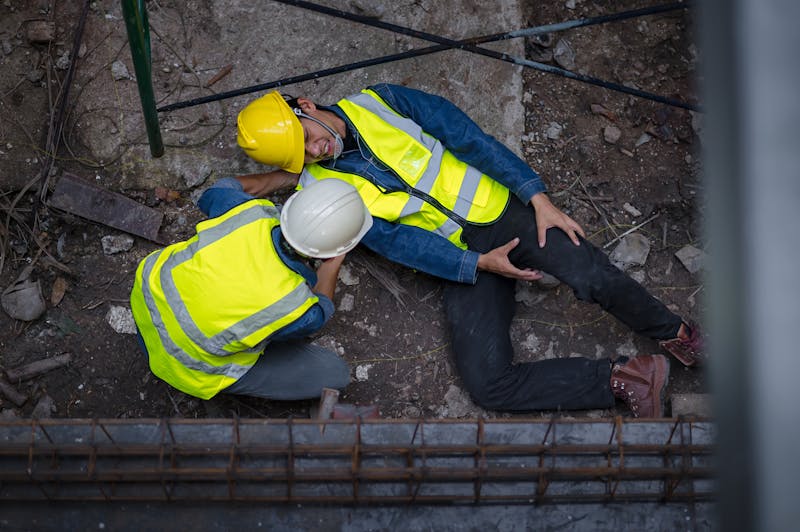
New York City construction sites are notorious for their complexity and the inherent dangers involved in their daily operations. With countless projects happening across the city, construction workers are exposed to significant risks, making Occupational Safety and Health Administration (OSHA) regulations critical to ensuring their safety. Unfortunately, OSHA violations are common, often leading to severe injuries or fatalities.
Here’s an in-depth look at the most common OSHA violations occurring on construction sites in New York City:
Fall Protection Violations (OSHA Standard 1926.501)
Falls are the leading cause of fatalities on construction sites, making fall protection one of OSHA’s most frequently violated standards. In New York City, high-rise buildings and skyscrapers are common, increasing the likelihood of fall-related accidents. Fall protection must be provided when workers are exposed to heights of six feet or more, and proper safety measures—like guardrails, safety nets, and personal fall arrest systems—must be implemented.
Common Violations
- Failure to provide fall protection for workers on elevated surfaces.
- Inadequate or missing guardrails on scaffolds or platforms.
- Failure to properly train workers on fall hazards and safety equipment use.
- Lack of safety nets in areas where guardrails are impractical.
Consequences
Without appropriate fall protection, workers risk serious injuries such as fractures, spinal cord damage, traumatic brain injuries (TBIs), and even death.
Scaffolding Violations (OSHA Standard 1926.451)
Scaffolding is ubiquitous on New York City construction sites. That said, OSHA often cites violations involving the improper assembly, inspection, or use of scaffolding. Unsafe scaffolding is one of the leading causes of accidents in New York City, with risks ranging from collapses to falls.
Common Violations
- Failure to provide guardrails on scaffolds more than 10 feet above ground.
- Inadequate scaffold support or incorrect bracing leads to instability.
- Improperly securing scaffolding to the structure.
- Allowing workers to use scaffolds without proper training on setup and usage.
Consequences
Scaffold-related accidents can cause severe injuries such as broken bones, spinal cord injuries, and traumatic brain injuries. Falls from scaffolding often result in permanent disabilities or fatalities.
Ladder Safety Violations (OSHA Standard 1926.1053)
Ladders are widely used on construction sites, but their improper use or faulty condition often leads to injuries. OSHA has clear guidelines regarding the selection, use, and maintenance of ladders to prevent accidents. Despite this, ladder safety violations remain prevalent on New York City construction sites.
Common Violations
- Using ladders that are damaged or not rated for the required load capacity.
- Failure to secure ladders or use them on unstable surfaces.
- Using ladders inappropriately, such as standing on the top rung.
- Lack of proper training for workers on ladder safety protocols.
Consequences
Improper ladder use can lead to falls, resulting in sprains, fractures, concussions, and, in extreme cases, paralysis or death.
Hazard Communication Violations (OSHA Standard 1910.1200)
New York City construction sites often involve the use of hazardous chemicals and materials. OSHA requires that employers properly communicate the dangers associated with hazardous substances through labels, safety data sheets, and worker training programs. Failure to comply with these requirements can expose workers to toxic chemicals, leading to serious health issues.
Common Violations
- Lack of proper labeling on hazardous materials.
- Failure to provide workers with safety data sheets for chemicals.
- Inadequate training on how to handle hazardous substances safely.
- Improper storage of dangerous chemicals.
Consequences
Exposure to hazardous materials can result in respiratory problems, chemical burns, eye injuries, and long-term illnesses like cancer or chronic lung conditions.
Respiratory Protection Violations (OSHA Standard 1910.134)
Respiratory protection is critical when workers are exposed to harmful dust, fumes, vapors, or gases. On construction sites, these hazards are prevalent during activities like demolition, sanding, or the use of toxic chemicals. OSHA mandates that employers provide appropriate respiratory equipment and ensure that it fits properly.
Common Violations
- Failure to provide suitable respirators for workers exposed to hazardous air contaminants.
- Lack of a written respiratory protection program or fit-testing procedures.
- Inadequate maintenance and cleaning of respirators.
- Failure to train workers on how to use respiratory protection equipment.
Consequences
Without proper respiratory protection, workers can suffer from severe lung conditions, including asthma, bronchitis, or silicosis. Long-term exposure to hazardous substances can also lead to life-threatening conditions like lung cancer.
Machine Guarding Violations (OSHA Standard 1910.212)
Many construction tasks require the use of heavy machinery and power tools, which pose significant risks if they are not properly guarded. OSHA mandates the use of guards on machines with moving parts to protect workers from amputations, lacerations, and other serious injuries.
Common Violations
- Failure to install appropriate guards on power tools or machinery.
- Removing or bypassing guards for ease of use.
- Inadequate maintenance of machine guards, leading to faulty equipment.
- Lack of training on safe machinery operation.
Consequences
Unprotected machinery can result in severe injuries, including amputations, crushed limbs, and deep lacerations. These injuries often result in permanent disabilities or long-term rehabilitation.
Electrical Safety Violations (OSHA Standard 1910.303)
Electrical hazards are a leading cause of fatal accidents on New York City construction sites. OSHA has strict regulations regarding the installation, use, and maintenance of electrical equipment to prevent shocks, burns, and electrocution.
Common Violations
- Improper grounding or bonding of electrical equipment.
- Failure to use ground fault circuit interrupters (GFCIs) in wet or damp conditions.
- Using damaged or defective wiring and cables.
- Failure to lock out or tag out electrical circuits during maintenance or repairs.
Consequence
Electrical accidents can lead to severe burns, shock injuries, or death by electrocution. These incidents often occur due to faulty wiring, inadequate protective equipment, or poor safety practices.
Lockout/Tagout Violations (OSHA Standard 1910.147)
Lockout/tagout (LOTO) procedures are critical in preventing the accidental release of hazardous energy during equipment servicing or maintenance. OSHA mandates that employers implement strict LOTO procedures to safeguard workers from electrical, hydraulic, or mechanical energy.
Common Violations
- Failure to develop and implement LOTO programs.
- Inadequate training on LOTO procedures for workers.
- Not providing proper lockout/tagout devices for isolating energy sources.
- Failing to perform routine inspections of LOTO programs.
Consequences
Violations of LOTO standards can lead to accidents involving moving machinery or equipment, resulting in amputations, crushing injuries, or fatalities.
Forklifts and Other Powered Industrial Trucks-Related Violations (OSHA Standard 1910.178)
Powered industrial trucks, including forklifts, are commonly used on construction sites to move materials. When operated improperly or without adequate training, these machines can cause serious accidents. OSHA requires that operators of forklifts and other powered industrial trucks be properly trained and certified.
Common Violations
- Failure to train workers on safe forklift operation.
- Using forklifts without ensuring they are properly maintained.
- Overloading forklifts or using them on unstable surfaces.
- Allowing unqualified personnel to operate powered industrial trucks.
Consequences
Forklift-related accidents can result in serious injuries, such as crushed limbs, head injuries, and even fatalities. Tip-overs and collisions are among the most common accidents caused by improper forklift use.
Cranes and Rigging-Related Violations (OSHA Standard 1926.1400 - 1442)
Cranes are essential for lifting and moving heavy materials on construction sites, but they are also one of the most dangerous pieces of equipment when not operated safely. OSHA has detailed regulations concerning crane operation, rigging, and inspections to prevent accidents.
Common Violations
- Failing to perform regular crane inspections.
- Using unqualified personnel to operate cranes.
- Improper rigging or failure to secure loads correctly.
- Operating cranes in unsafe weather conditions, such as high winds.
Consequences
Cranes and rigging failures can cause catastrophic accidents, including dropped loads, crane collapses, and worker fatalities. Injuries caused by crane accidents often involve multiple victims, leading to serious liability issues for contractors and subcontractors.
Fall Prevention Training-Related Violations (OSHA Standard 1926.503)
Proper fall prevention training is critical for all workers exposed to fall hazards. OSHA mandates that employers provide adequate fall prevention training to ensure workers understand how to use safety equipment, such as harnesses, guardrails, and nets. In New York City, failure to provide fall training is a significant cause of worker injuries.
Common Violations
- Lack of initial fall prevention training for workers exposed to fall hazards.
- Inadequate retraining after changes in job duties or safety equipment.
- Failure to document fall prevention training sessions.
Consequences
Without proper fall prevention training, workers are more likely to make critical errors that result in falls, causing severe injuries such as broken bones, TBIs, or death.
Eye and Face Protection-Related Violations (OSHA Standard 1926.102)
Construction sites are filled with hazards that can injure workers' eyes and faces, such as flying debris, chemicals, and sparks from welding. OSHA requires that employers provide appropriate eye and face protection based on the specific hazards present.
Common Violations
- Failure to provide adequate eye or face protection in hazardous environments.
- Allowing workers to use damaged or improper protective gear.
- Lack of training on when and how to use protective eyewear or face shields.
Consequence
Eye and face protection violations can lead to severe injuries such as vision loss, chemical burns, and facial lacerations. These injuries are often permanent and can significantly affect a worker's quality of life.
Our Battle-Tested NYC Personal Injury Lawyers Will Pursue the Highest Compensation for You
When an employer’s negligence and failure to follow OSHA regulations lead to your accident and injuries, you deserve justice and compensation. Michael S. Lamonsoff, Esq. "The Bull" is one of New York City's most successful personal injury attorneys. At the Law Offices of Michael S. Lamonsoff, we have over 150 years of combined litigation experience and a record of more than half a billion dollars recovered in settlements and verdicts for injured victims. Our legal team is determined to fight for the largest possible compensation for your injuries and losses. To schedule your free consultation, call us at 212-962-1020 or fill out this online contact form.


